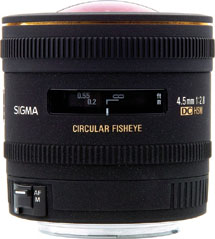Sigma’s Fisheye Duo; The Sigma 4.5mm f/2.8 EX DC HSM & 10mm f/2.8 EX DC HSM (Motor-In) Lenses Page 2
The City At Night |
|
 |
|
|
The 10mm f/2.8 fisheye (MSRP $1000, less in various outlets) saves you a bit
of coin and while it delivers less distortion (and that's a very relative
statement) it is certainly one that delivers an exciting fisheye experience.
Keep in mind that these lenses are of the DC variety, so multiply by the appropriate
magnification factor for your digital camera (1.5 for Nikon and 1.6 for Canon).
By the way, if you want to use a filter for either lens the front element makes
that impossible so you can insert a gelatin filter in the rear of the lens,
if desired.
I shot with the 10mm in daylight, roaming around the canyons of New York City
and having a ball bending lines and creating decidedly odd points of view. I
am sure passersby thought I was slightly crazy (but then again, it's New
York City so nothing unusual there) bending backward to get my point of view.
The funny thing is they couldn't know they might have been included in
the picture. In fact, if you shoot straight ahead with the 4.5mm lens, watch
out for your shoes appearing in the bottom of the frame!
Surreal Scenes |
|
 |
|
|
One thing you would notice if you shot with the lenses side by side is that the 10mm creates a slightly larger image circle on the sensor, which means you crop more to rid the black frame around the circle. This might be of concern to those with lower megapixel sensors, as cropping drops file size accordingly. But for those with a test for the fisheye look, these lightweight lenses certainly do the trick. While flare is certainly well controlled on the image itself you might see a halo effect in the non-image field when shooting around bright light sources. And while the Matrix meter in the D40X did a great job overall with exposure, the super-wide field of view is best read using spot metering to control highlights, or, simply shooting in bright light with a minus EV compensation--you should test under each lighting condition to see which method delivers the best results.
Technical Specifications |
||
 |
 |
|
Lens |
10mm f/2.8 EX DC HSM |
4.5mm f/2.8 EX DC HSM |
| Construction |
12 elements, seven groups |
13 elements, nine groups |
Angle Of View |
154° (180°, Nikon; 167°, Canon) |
180° |
Max/Min Aperture |
f/2.8, f/22 |
f/2.8, f/22 |
Size |
3.0x3.3" |
3.0x3.1" |
Weight |
16.8 oz |
16.6 oz |
Mounts |
Canon, Nikon, Sigma |
Canon, Nikon, Sigma |
Price (MSRP) |
$1000 |
$1400 |
For more information, contact Sigma Corporation of America, 15 Fleetwood Ct., Ronkonkoma, NY 11779; (800) 896-6858; www.sigma-photo.com.
- Log in or register to post comments

































